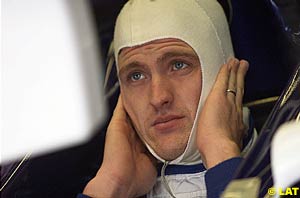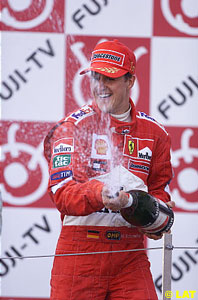
This week's Grapevine brings you |
![]() Ralf Under Pressure
Ralf Under Pressure
Despite Frank Williams and Patrick Head providing plenty of visible support, backing up Ralf Schumacher in Japan, the media are having a field-day over his performances relative to Juan-Pablo Montoya in the second half of the season.
 Last year, plenty was made of Jenson Button closing down his more experienced teammate for form, and despite Schumacher maintaining an upper hand throughout, the newcomer was acclaimed as rookie of the year, promising a huge future and probable world championships. Indeed, the whole concept of moving him out to Benetton was widely criticised, even if it was to bring in Montoya. Even more so when Montoya struggled to match Ralf in the early races.
Last year, plenty was made of Jenson Button closing down his more experienced teammate for form, and despite Schumacher maintaining an upper hand throughout, the newcomer was acclaimed as rookie of the year, promising a huge future and probable world championships. Indeed, the whole concept of moving him out to Benetton was widely criticised, even if it was to bring in Montoya. Even more so when Montoya struggled to match Ralf in the early races.
However, as Montoya has said all along � like Alex Zanardi before him, for that matter � this car is a very different beast to the CART offerings he drove before, and it requires a different approach to get the best out of it. More work outside the car, to maximise understanding of the technologies and tactics, and prolonged concentration and sensitivity in the car, to keep it on the knife edge of performance. It took until Canada, and his second self-inflicted crash, to bring home what that difference was, but since then, there has been no looking back.
Talking to Montoya, he's pretty blase about what's required. His words can be summarised as "work harder" � but his mechanics think this simple conclusion is doing him an injustice. They believe his actual driving has lifted to another level, and suggest watching him on track now, compared to the start of the season: there's a telling contrast.
At the start of the season, Montoya's attacking style was costing him time � relative to Ralf's very smooth approach, that is. Montoya started the season by attacking corners, which left him in a drifting car, giving him a choice between making a slower entry, or losing time in the mid-corner or exit as he corrected the slide. One of the things that modern F1 cars on grooved tyres do not appreciate is being slid around corners.
 However, a lot of things changed in half a season. Michelin's tyres have got better, for a start, and they are more forgiving when used too hard in cornering. The circuits visited in the later stages � Spa, Monza, Indy and Japan � offer good returns to bold, aggressive driving. And Williams have developed a new chassis � which Montoya was able to use for his first race win in Monza. And, of course, Montoya himself has adapted. He still attacks the corners: anyone watching him try to close Michael Schumacher down in Japan can be left in no doubt about that; but he has more sympathy to the car's needs when doing it. Now, he puts the car right on that break-away point, and sits with the beginnings of the slide. And holds it by feel, right through the corner. His control is so fine, that when he goes over the limit, he picks the car up again with backing off, as he was at the start of the year. It's in direct contrast to Zanardi's attempt at driving the Williams, when he never quite picked up that feel from the grooved tyres, which meant he could never quite get the absolute maximum of pace that he, or the team, was looking for.
However, a lot of things changed in half a season. Michelin's tyres have got better, for a start, and they are more forgiving when used too hard in cornering. The circuits visited in the later stages � Spa, Monza, Indy and Japan � offer good returns to bold, aggressive driving. And Williams have developed a new chassis � which Montoya was able to use for his first race win in Monza. And, of course, Montoya himself has adapted. He still attacks the corners: anyone watching him try to close Michael Schumacher down in Japan can be left in no doubt about that; but he has more sympathy to the car's needs when doing it. Now, he puts the car right on that break-away point, and sits with the beginnings of the slide. And holds it by feel, right through the corner. His control is so fine, that when he goes over the limit, he picks the car up again with backing off, as he was at the start of the year. It's in direct contrast to Zanardi's attempt at driving the Williams, when he never quite picked up that feel from the grooved tyres, which meant he could never quite get the absolute maximum of pace that he, or the team, was looking for.
Of course, there's no quicker way to take a corner than right on the limit of adhesion; so in theory, Ralf should still be quicker. Compared to Montoya, he is smoothness personified, cornering on rails without sliding: and his telemetry is in keeping with his feedback, demonstrating he is cornering as fast as he can make the car go. His mechanics back him up, saying he is driving to the level of his car's setup, and so finds himself limited by the balance on the car. When he gets it spot on, he still out-paces Montoya, as demonstrated in qualifying at Indianapolis. But if not, Montoya's style lets him push the car through some of its imperfection, and he qualifies ahead of Ralf...
So, whilst the media are speculating on Ralf's future, from the viewpoints of Head and Williams, this is not a problem. They know that the real issues lie with the car, and making sure it can be properly balanced. Ralf is a known quantity, and he is certainly capable of delivering the goods. Certainly, they picture a return to form next year, and a close tussle between the teammates, when Michelin produce tyres that don't need 20 laps of scrubbing in, leaving the drivers plenty of time to get the cars set up to their liking!
![]() Ferrari Coasting Into 2002
Ferrari Coasting Into 2002
The atmosphere at Maranello is most un-Ferrari like. Even at the end of last season, after clinching their first Drivers' Championship in decades, there was not the atmosphere of relaxation and fun that is currently pervading the shop floor � and it's not all down to the best part of two months holiday coming up, either.
 Schumacher's dominant year has highlighted the strength of this year's car. From conception, it's been something of a joy to the designers and drivers: at every race this season, it has been easy to set up, and the fastest runner there, or close to it... when it has run full distance, it has been worth at least a podium finish.
Schumacher's dominant year has highlighted the strength of this year's car. From conception, it's been something of a joy to the designers and drivers: at every race this season, it has been easy to set up, and the fastest runner there, or close to it... when it has run full distance, it has been worth at least a podium finish.
The strength of the car has been obvious since Melbourne: it has no real weakness, and work through the season has continued to ensure whatever areas are weakest get developed, like, for example, the effort to reduce fuel consumption early on. Accordingly, when the designers sat down to start working on the 2002 design back in June, they decided that next year's car should be an evolution of this year's.
There are rumours of some interesting developments coming. For example, there has been some speculation that the Research and Development boffins have worked out an effective way to remove the clutch. Given this comes to a fist sized lump of metal in the drive train, it seems like a trivial concept, but the knock on benefits could be sizeable � ranging from reducing mass by around 2.5 kg, to (potentially) housing the gears within the engine casing. Another engineering trail has been looking at how to more effectively use the wheel rims for cooling the brakes, which might well result in a new braking system that cuts the unsprung mass on each wheel by around half a kilo � whilst reducing the interruption to the airflow around the wheel.
Otherwise, improvements seem to be coming in the form of tweaks to the aerodynamics, evolving the suspension, and letting the engine department try and see if they can get more power out of the new evolution engine than the software experts can control with the traction control system.
The biggest irony, of course, is that this plan is pretty much the motto of the team expected to be Ferrari's closest rival next year: Frank Williams is well known for his refrain: "evolution, not revolution." After all, he built the most dominant team of the nineties on it.
Please Contact Us for permission to republish this or any other material from Atlas F1.
|
Volume 7, Issue 42 Atlas F1 Exclusive
Exclusive Interview with Michael Schumacher
Japanese GP Review
The Japanese GP Review
Changing Tactics
He is the Champion
Columns
The F1 Insider
Season Strokes
The Weekly Grapevine
> Homepage |
